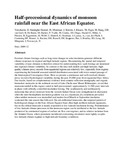Half-precessional dynamics of monsoon rainfall near the East African Equator.

View/
Date
2009-12Author
Verschuren, D
Sinninghe Damsté, JS
Moernaut, J
Kristen, I
Blaauw, M
Fagot, M
Haug, GH
van Geel, B
De Batist, M
Barker, P
Vuille, M
Conley, DJ
Olago, Daniel O.
Milne, I
Plessen, B
Eggermont, H
Wolff, C
Hurrell, E
Ossebaar, J
Lyaruu, A,
van, der Plicht J
Cumming BF, Brauer
A, Rucina
SM, Russell
JM, Keppens
Hus, J
Bradley, RS
Leng, M
Mingram, J
Nowaczyk, N
Type
ArticleLanguage
enMetadata
Show full item recordAbstract
External climate forcings-such as long-term changes in solar insolation-generate different climate responses in tropical and high latitude regions. Documenting the spatial and temporal variability of past climates is therefore critical for understanding how such forcings are translated into regional climate variability. In contrast to the data-rich middle and high latitudes, high-quality climate-proxy records from equatorial regions are relatively few, especially from regions experiencing the bimodal seasonal rainfall distribution associated with twice-annual passage of the Intertropical Convergence Zone. Here we present a continuous and well-resolved climate-proxy record of hydrological variability during the past 25,000 years from equatorial East Africa. Our results, based on complementary evidence from seismic-reflection stratigraphy and organic biomarker molecules in the sediment record of Lake Challa near Mount Kilimanjaro, reveal that monsoon rainfall in this region varied at half-precessional ( approximately 11,500-year) intervals in phase with orbitally controlled insolation forcing. The southeasterly and northeasterly monsoons that advect moisture from the western Indian Ocean were strengthened in alternation when the inter-hemispheric insolation gradient was at a maximum; dry conditions prevailed when neither monsoon was intensified and modest local March or September insolation weakened the rain season that followed. On sub-millennial timescales, the temporal pattern of hydrological change on the East African Equator bears clear high-northern-latitude signatures, but on the orbital timescale it mainly responded to low-latitude insolation forcing. Predominance of low-latitude climate processes in this monsoon region can be attributed to the low-latitude position of its continental regions of surface air flow convergence, and its relative isolation from the Atlantic Ocean, where prominent meridional overturning circulation more tightly couples low-latitude climate regimes to high-latitude boundary conditions
URI
http://www.ncbi.nlm.nih.gov/pubmed/19956257http://erepository.uonbi.ac.ke:8080/xmlui/handle/123456789/58043
Citation
Nature. 2009 Dec 3;462(7273):637-41. doi: 10.1038/nature08520.Publisher
University of Nairobi, institute for climate change and adaption
